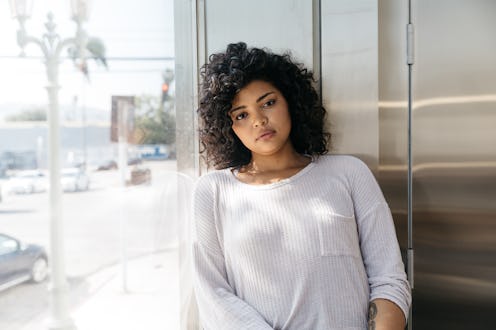
Forty million American adults experience anxiety, but anxiety looks different to different people. So, psychologists have classified several types of anxiety disorders to characterize people’s experiences. Learning the ways anxiety can manifest might help you figure out if you suffer from any of these conditions and if you need help.
“Based on my vast experience in dealing with treating anxiety in kids, adolescents, and adults, if a patient truly cannot turn off the worries in their mind and it has become an obsessive compulsive cycle, the only successful treatment I have seen work is a combination of Cognitive Behavioral Therapy (CBT) and the correct choice/dosage of anti-anxiety medication prescribed by a well-trained psychiatrist,” Dr. Fran Walfish, Beverly Hills family and relationship psychotherapist, author of The Self-Aware Parent, regular expert child psychologist on The Doctors, CBS TV, and co-star on Sex Box, WE tv, tells Bustle. “All the talk therapy in the world will not help a patient who is suffering from obsessive thoughts and worries.”
Other than that, Walfish recommends getting a good night’s sleep, doing something relaxing like reading before bed, surrounding yourself with people who make you feel good, being careful about what you read online, and practicing self-care.
How do you know if you’re suffering from an anxiety disorder or just run-of-the-mill anxiety, though? Here are five of the most common anxiety disorders.
1Generalized Anxiety Disorder
This condition is what it sounds like: a tendency to worry excessively about a number of things, which might include work, money, health, and relationships, Leesha M. Ellis-Cox, M.D., M.P.H. tells Bustle. Besides the obvious symptom of frequent anxiety, Generalized Anxiety Disorder can also lead to insomnia, irritability, fatigue, and muscle tension.
2Social Anxiety Disorder
Social Anxiety Disorder is also known as Social Phobia, and that’s what it is: a fear of social situations. People with this condition are often afraid to meet new people and have trouble making friends because they believe they will be rejected, says Ellis-Cox. They may also be afraid of public speaking and other situations where they’re in a position to be judged.
3Panic Disorder
You might’ve heard of a panic attack, when someone gets extremely scared and experiences an elevated heart rate, shortness of breath, chest pressure, dizziness, and other physical signs of anxiety. During a panic attack, people often fear they’re going to die, says Ellis-Cox. Panic Disorder occurs when you have panic attacks over and over again. You may even develop a fear of having another one, known as “anticipatory anxiety.”
4Specific Phobia
Many of us have some phobia: an irrational fear of something, whether it’s snakes or spiders or heights, even when it doesn’t pose a threat to us. This requires psychological help when the measures you take to avoid the thing you’re afraid of interfere with your life, says Ellis-Cox.
5Separation Anxiety Disorder
This is most common in children, but it exists in adults, too, says Ellis-Cox. Those with it will be afraid to leave their loved ones’ sides, get anxious when they’re away, and even have nightmares about losing them.
If you’ve been struggling with anxiety, whether it fits one of these descriptions or not, try these anxiety reduction techniques and look for a therapist you vibe with. Therapy works when it’s the right match, and there’s absolutely no shame in going.